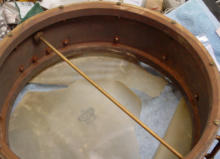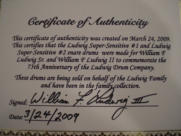
Once you get bitten by the vintage drum bug...it's all over.


Collector’s Showcase: Mike Curotto
Jim Messina’s Vintage Drums Talk.com
Click on any photo for a larger version.
(portions originally published in No So Modern Drummer Magazine)

I love gold plated snare drums from the 1920s! The fancy engraving pattern on this Multi-Model is one that I have never seen
before so maybe this drum was a one-off/special order. Master-engraver John Aldridge concurs that he has never seen this
engraving pattern either so this pattern is now in his engraving photo archives.
This drum came to me with all original parts (except top and bottom heads) and in good but dirty condition. Ah, the marvel of
lemon oil! The shell was very dusty and faded so I hit the shell with some lemon oil and the gold plating brightened up like a
champ and the fancy engraving now pops out like it should. The hardware was another story though. The Multi-Model rims,
being steel, were rusty in a lot of places so I cleaned the rust as best as I could and shot the rims with some clear lacquer.
There is not much more that you can do here aside from a complete stripping, re-plating and re-lacquering. You would think that
Leedy would have done a better job of under plating the steel rims before the gold plating was applied to the rims. The 2-hole
lugs, Utility strainer, butt plate and heater plate were in a little better shape but I clear coated them also. You have to look closely
but you can see the Multi-Model Leedy Indianapolis stamp on the top rim, you can clearly see Leedy Drum Co Pat. Dec. '12 on
the Utility strainer. I had a pair of original Leedy Hardwhite heads so I put those on the drum as a finishing touch. So here I
present to you another cool, old snare drum brought back to life.
1922-24 Leedy 5x14 gold plated/fancy engraved Multi-Model
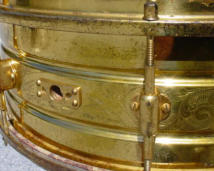
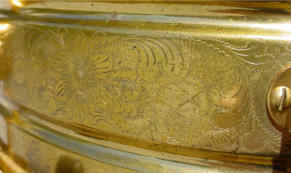
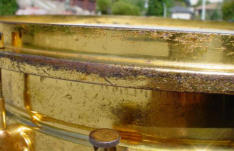
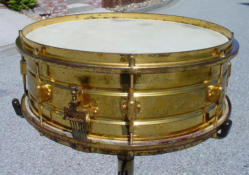
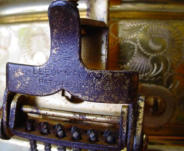
This drum is all original and in very good condition. I could have left everything as it was and be done with it but I had to get
my little hands on this puppy. Fortunately all the drum needed was a nice cleaning/polishing. The Rose Pearl had a few layers
of gunk that my normal regimine of GooGone, Meguires #17 plastic cleaner and #10 plastic polish easily took care of. The
Rose Pearl is the glue grid type wrap that I have also seen on some Ludwig & Ludwig, Leedy, Liberty and Slingerland drums
that I own. The hardware was in very good shape but my Cape Cod Polishing Cloths brightened every up even more to a nice
shine. The Tone Flange (hubcap) is the aluminum with holes version and sits nicely on the shell. This was a very easy
cleaning/restoration. Enjoy.
1929 Slingerland 5x14 Rose Pearl Tone Flange Artist Model
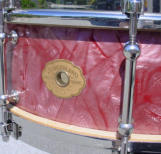
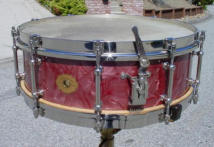
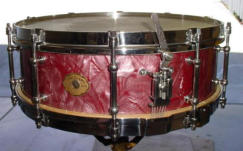
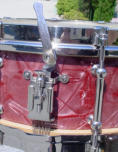
Here are some of the highlights from the world-class collection of Mike Curotto.

This drum had some bad mojo on it, here's the story. This drum was on eBay a few years ago, the sellers were a bit clueless on
how to shop the drum or the drum's value so after a few calls to the resident experts in the field they put it on eBay. There was
some interest back and forth, then the sellers pulled the auction and then one of our fellow collectors offered 7000.00 for the
drum after the auction was over. I talked to the sellers and they said they turned down the 7000.00 offer because they had a
"9000.00 offer from Japan". I called back after a few weeks and found out that they still had the drum so I inquired as to the
"9000.00 offer from Japan" and they said that they were now going to keep the drum for their kids as it will be worth more money
later on (read) there was no "9000.00 offer from Japan"...I think that they got greedy and blew it. So a few months ago I see this
drum on eBay for a BIN of 4995.00...sold!
I love these Slingerland DuAlls, they are very rare, (very few were made, less than a year in production), they look cool, they are
historic etc...but man what a royal pain in the ass to work on. These drums remind me of an ancient wooden ship that goes in for
restoration; creaking wood, tweaked, malformed parts and just a whole lot of "oldness" to deal with. The Tone Flange (hub cap)
requires a certain amount of wrestling in order for it to fit on the 75+ yr. old shell, the DuAll mechanism has a bunch of small parts
that one needs to memorize (diagram) in order to remember the sequence of assembly and then when the drum is back together \
you hope everything works.
This drum is all original but still had a few issues. The black enamel shell was split open at the seam but my good friend Al
Schneider (The Drum Doctor) was able to fix that right away and the black enamel needed only a basic cleaning, polishing and
detailing. The Artgold hardware was in very good shape but was very dirty with a small amount of tarnishing so I did my normal
cleaning and restoration on the hardware. Enjoy.
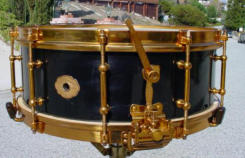
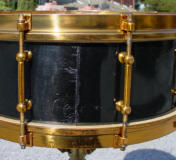
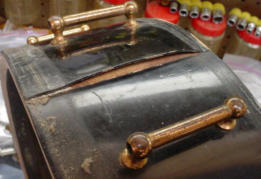
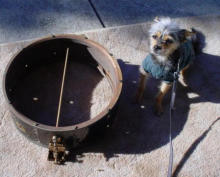
1934 5x14 Slingerland Black Enamel/Artgold DuAll Model

WFL III (B III) offered WFL I & II to a few collectors, when it was my turn I placed a bid (actually 2 bids), my offer was accepted
and here we are. A few months later, thanks to my good friend and fellow collector Bun E. Carlos, the Ludwig family is now intact;
WFL I, II & III serial #s 1, 2, 3 75th Anniversary snare drums are in the collection. After I received #s 1 & 2 I emailed Bun and
asked: "I would never ask you if I didn't already know that you own 3 of these 75th Anniversary snare drums, one being B III's,
so would you consider selling or trading B III's 75th Anniversary snare as you know that I like sets of things"...Bun's email back
was: "Its home is with you, we'll do the deal at the Chicago Show" ...So we did the deal at the 2009 Chicago Show, along with a
few other snares. Thanks again to my friend and fellow collector Bun E. Carlos for being very cool.
These three drums are 100% original and in mint-minus condition but I decided to replate everything anyway...HA...got ya...
The drums needed a little dusting, a little wiping off and minor tuning, that's it. This seemed like the right time to buy these drums;
Ludwig's 100th Anniversary and the passing of WFL II last year so I went for it. David Anfuso assisted in the WFL I & II deal and
sent some nice photos to add to the letter of provenance. B III included a nice letter of provenance with the story behind the 75th
Anniversary snare drums that I had only heard about in pieces throughout the years. The story goes that since the 75th
anniversary is the diamond anniversary the original plan was to have a diamond chip placed in the "i" of anniversary on the
commemorative plaque. The jewels were secured, a prototype was made and everyone was thrilled so the plan was to install the
diamond chip on all 75-80 snare drums. The bag of jewels was left with the head of manufacturing at the Ludwig plant and from
that day on the jewels disappeared so the prototype was dismantled and the drums were produced without the diamond chips.
(NB: In no way am I implying that the head of manufacturing at that time had anything to do with the theft of the diamond chips.)
I know of two collectors that have drums with the diamond chips on the 75th Anniversary plaque so maybe a few got away before
production was halted/altered. The engraving is the laser-engraved 10 point floral pattern similar to the 1929-only 10 point floral
pattern. One interesting thing that I noticed on all three drums was the absence of engraving in the top half of the panel that is left
of the butt side SS mechanism. Any ideas why that happened? Any 75th owners out there with the same situation? If you look at
the top half of the shell starting at the butt side SS mechanism and move to the right you'll have drilling for the SS mechanism,
tone control, Ludwig badge, 75th Anniversary plaque, engraving, lever side SS mechanism, engraving, engraving, engraving and
then the blank area. It doesn't seem logical to me why the engraving would be left out in that area but what do I know, I voted for
Nixon. I did hear that these panels were left blank because that's where the 75th Anniversary plaque was originally supposed to
be placed, so now I hear all of you enquiring minds asking (in unison) the logical question: "So is there engraving under the 75th
Anniversary plaque?" There is engraving on every panel in the bottom half of the shell except for the areas (top and bottom)
where the SS mechanism is. So feel free to weigh in on that one as I'd love to know the answer or at least some of your theories
(my contact info is at the bottom of this column). There is a "B" stamp right above the tone control and the "Ludwig Chicago"
within the engraving in the top of the panel two over from the SS mechanism (lever side). I especially enjoyed the label on the
bottom of Sr.'s drum: "ANNIVERSARY SNARE serial #1 Wm. F. Ludwig, Sr.-
MUSEUM CONFERENCE ROOM - DO NOT REMOVE"...great history from a legendary family.
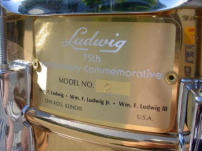
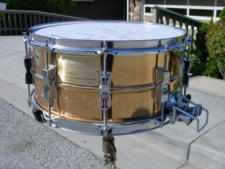
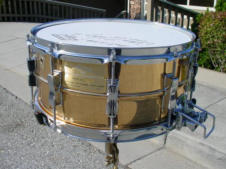
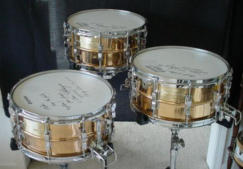
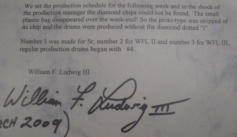
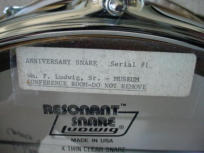
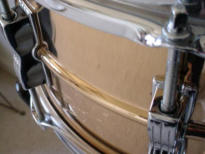
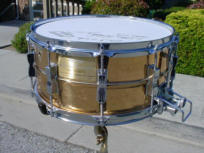
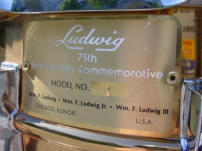
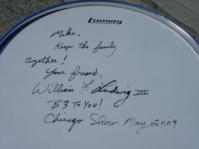
1984 Ludwig 75th Anniversary 6.5x14 Brass/engraved Super-Sensitive Model - WFL Sr. #1
1984 Ludwig 75th Anniversary 6.5x14 Brass/engraved Super-Sensitive Model - WFL Jr. #2
1984 Ludwig 75th Anniversary 6.5x14 Brass/engraved Super-Sensitive Model - WFL III. #3


Bidding and sniping in the trenches of eBay is how this drum was obtained...
This snare drum is a 1924-28 Leedy Standard Model. The specs are the usual 1920s Leedy Indianapolis stamp, 5x14 shell
size, solid mahogany shell, pre-badge grommet, 8 tube lugs, slotted tension rods and the 2-hole 1924-28 Presto throw off. Now
for the fun part...picture yourself in an 1800s-1900s historical landmark type house; you may notice wall paper that looks to be
"raised" or embossed looking, that is the manner in which this drum is finished. The gold colored wrap on this drum has the
same glue grid backing as does the Red Onyx Leedy that was in my last column but with a swirl-like raised/embossed texture to
it. This seems to be an un-cataloged finish or maybe a variation of the Leedy Colonial Gold finish but definitely original factory
as there was a matching bass drum and two fellow collectors/friends who both verified that they had seen this finish before.
I was also pleasantly surprised to find out that hardware is gold plated and in very good shape. The inside of the shell is a little
different than your normal wood Leedy of the era; it looks to be solid mahogany with maple reinforcement rings and two wider
strips of maple that are separated leaving a "channel" in the middle. The hardware cleaned up very easily but the "wall paper"
was another story and needed a more aggressive approach..."Curotto-izing" if you will. I needed a cleaning solution with a little
(very little) abrasion to it so after a bit of experimenting I was able to get a few layers of yesteryear off with a solution of baking
soda and white vinegar. I wasn't going to press my luck anymore so I ended off the cleaning process with a light coat of lemon
oil. Factory original, un-cataloged finish, one-off special order?...any thoughts?
1924-28 5x14 Leedy Standard Model gold plated/gold "wall paper" drum
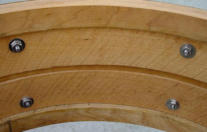
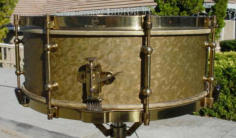
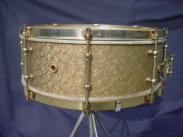
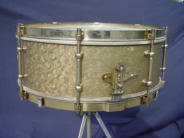
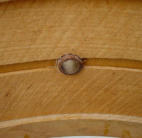
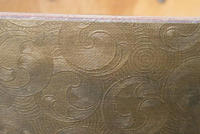
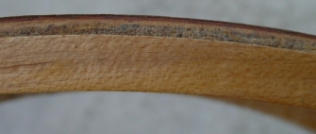

This drum has a quasi-Slingerland vibe to it as you all can easily see. The 8 lug shell is 3-ply mahogany with maple
reinforcement rings. The Capri Pearl wrap is in very good condition and the seams (there are two seams) are strategically
placed in line with a tube lug. The wrap cleaned and polished up nicely. The chrome hardware was in very good condition
aside from the normal weathering that happens to the steel tension rods but everything cleaned and polished up nicely.
The tension rods are slotted. The collar hooks are similar to the Slingerland "chubby" versions and are chrome over steel,
nice and strong. The 3-pt. strainer is very Slingerland-like with exception to the thumbscrews on the strainer tension plate
and the extension lever. The extension lever has no marking/stamp. The guys at Carlton must have studied with the
assemblers at Slingerland as the 3 pt. strainer hole pattern on this drum has that Slingerland "dip to the right" drilling in the
hole pattern. I especially liked that the "Carlton Standard" stamp is on the top and bottom rims. There is no badge. The air
hole is right above the butt plate and is secured to the shell like a grommet. I used the heads and wires that came with the drum.
There you have it...Dear diary...Curotto goes European!
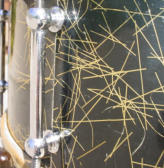
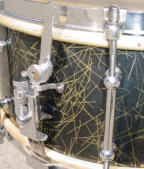
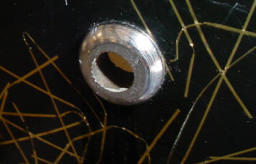
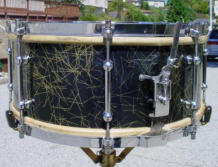
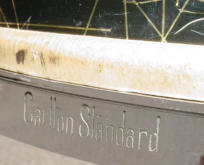
1930s 6.5x14 Capri Pearl Carlton Standard Model
First of all a big "thank you" has to go out to my good friend and fellow collector Bill Wanser for brokering this deal with Scot
Colner of Olympic Drums (Portland, Oregon). Bill also shared his research with me as to the documentation of the year,
model and finish of this very rare snare drum.
Let's start with the documentation. The Standard-Sensitive Model and Rose Pearl finish never made it into an L&L catalog.
The only mention of the L&L Standard-Sensitive Model is on pg. 13 (pg. 178 in the Ludwig Drummer compilation) of the Fall
1929 Ludwig Drummer magazine. The only reference to Rose Pearl is on pg. 17 (pg. 182 in the Ludwig Drummer compilation)
in that same Fall 1929 Ludwig Drummer. I love the Rose Pearl description by L&L: "Rose 'Pearl' is a red hot finish for red hot
drummers. It has the zipp (sic), and the Pep, and is just what the collegiate chap has been looking for. Rose 'Pearl' looks best
with DeLuxe rods....Prepare for that better job by getting a set of new Ludwig 'Pearl' drums. (These finishes are too new to be
included in our large drum catalog but samples will gladly be sent to anyone interested)".
Well, this drum doesn't have DeLuxe (Artgold) rods and the nickel hardware needed a good cleaning and polishing but all of
the hardware came out great. I am told that the original owner of this drum actually marched with this drum. Evidence of this
is the two holes (nicely done by the way, they actually look like they were drilled at the factory) on the top rim to accommodate
a marching sling and the plate near the butt plate to accommodate a lyre (music stand). I decided to keep these two artifacts
intact as I feel that this adds a nice provenance to the drum. The Rose Pearl had some fade, was intact but was really dirty,
grimy and had layers of 80 year old schmutz. (Note to self: Never march in the sun with a drum that has a rare pearl finish).
There was a small split in the finish behind the lug just left of the butt plate. Thanks again to Bill Wanser for his expert repair
of the split. I hit the shell with my usual salvo of Goo Gone, Meguiars's #17 cleaner and Meguiars's #10 polish. The Rose
Pearl cleaned up and polished up nicely. Both the Sensitive wires (under the top head) and James Snappi-wires were in
great shape. I put on some good top and bottom calf heads and there you have it; a one-year-only model production and a
one-year-only pearl finish all wrapped up into a 1929 Ludwig & Ludwig Rose Pearl Standard-Sensitive Model. I'm feeling
pretty red hot, zippy and peppy right now!
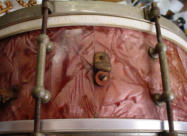
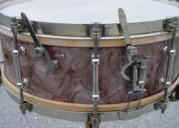
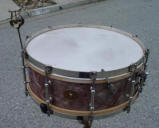

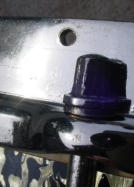
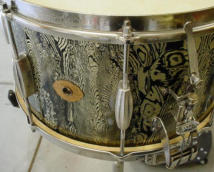
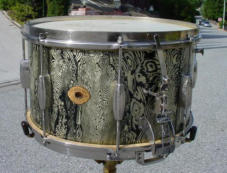
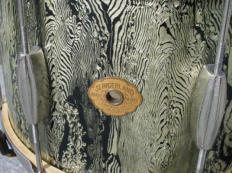
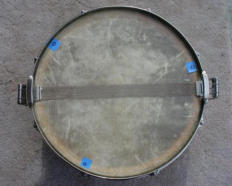
At first I thought that I had gotten ripped off but it turns out that I learned something new while cleaning this drum. It seems that
the WFL Drum Co. chose to alter the beads (inside and outside) on their metal shells rather than "notch out" the single or twin
strainers in order to make the them fit onto the beaded shell. So I take this drum apart and see the altered bead on the outside
and inside, I immediately got out my 1930s nob All-American Swing Model and my 1930s 7x14 WFL cob Twin Strainer Model
and voila, the same shell/bead alterations are on both of those too! I never really paid attention to this detail before as there
were no extra holes or any other anomalies on these drums so this was a pleasant new discovery for me...The photos say it all.
The nob shell was in great shape and needed only a basic cleaning and polishing. The badge is one of the earliest WFL lyre
badges with "Wm F. Ludwig Drum Company" at the bottom of the badge.
The hardware was also in great shape (except for the Imperial lugs) but everything cleaned and polished up nicely.
So how many of you out there already knew of this bead/shell alteration?
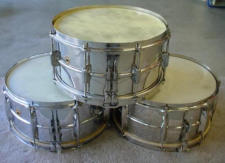

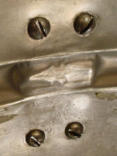
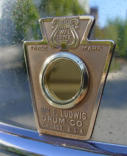
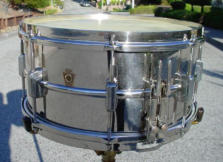
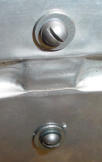
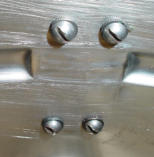
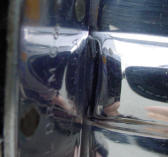
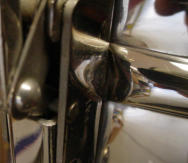
1936 Slingerland 8x14 Abalone Pearl Bernie Mattison Model Radio King
1930s WFL 7x14 (nob) Imperial Lug Twin Strainer Model



I purchased this drum at the Chicago Show (circa 2002) from my good friend Todd Remey, the Drum Detective. The drum was
missing all the tension rods/washers, the two Dual mechanism thumbscrews, both "spoon" levers, top and bottom wires and top
and bottom heads. I grabbed the drum anyway as I knew that I had all of the correct of-the-era missing parts in my spare parts
stash at home. I know a lot of you have experienced that mild elation (deftly hidden from the seller of course) when you see a
rare drum that is missing parts but you know you have the correct parts to bring it back to life. Let's all hear it for our spare-parts
stashes! The existing hardware, plus my hardware all cleaned up and polished up nicely. The silver sparkle was in good shape
(no cracks, splits, bubbles) with some "cancer" spots but also cleaned and polished up nicely. The Full Dress pattern is one that
I haven't seen in any of the Leedy catalogs; the pattern is a group of 4 notes (64th/32nd/16th/8th) in 4 different sparkle finishes
(blue/gold/red/green) in each panel except for the panels where the Dual mechanism is located. I checked the Leedy catalogs
that I have and found the normal Full Dress diamond configurations in the Leedy 42-A catalog and the same diamonds with
different shape options in the Leedy 43 catalog. Both catalogs offer the Full Dress in "Sparkling Gold, Green, Red or Silver
Pyralin", (Sparkling Blue is not listed). I would say that it is logical to assume that this Full Dress pattern was a special order
one-off. Leedy catalog "O" did state: "Special scenes, figures, lettering or designs will be painted to order from sketches, photos
or pictures..." so I am certain the same would go for producing a custom design using the Sparkling Pyralin.
Here's an observation; the Leedy 42-A and 43 (1937-38) catalogs both show a "Top Hat & Cane" design at the top of the page
that looks identical to the Ludwig & Ludwig 1941 TH&C pattern that we all know and love. So I pose this question for you to
cogitate on; did Leedy, or for that matter, C. G. Conn come up with the TH&C pattern first in the late 1930s? As always please
feel free to weigh in if you have more data to add to this, my contact info is at the end of my column. And finally, the placement
of the Leedy badge...the photo says it all.
1935 Leedy 6.5x15 Sliver Sparkle/Full Dress Broadway Dual Model
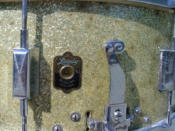
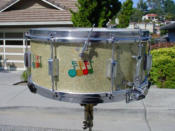
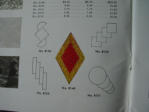
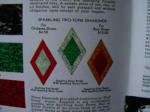
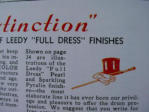
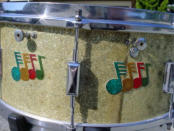
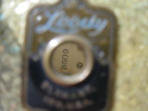
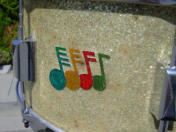

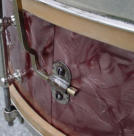
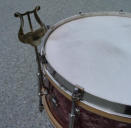
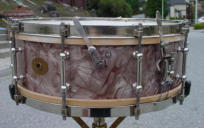
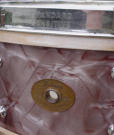
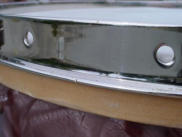
1929 5x14 Ludwig & Ludwig Rose Pearl Standard-Sensitive Model
Many years ago I got up early on a rainy Sunday morning and drove out to the coast to get this weird drum. The drum is all
original except for the heads. The drum has chrome hardware, a solid shell and a chrome type of wrap on the shell. The inside
of the shell says "okay chrome" so does this mean it's OK to put chrome on the shell at the factory? "Okay" is an older way of
saying "OK". The chrome wrap is attached at the seam via small rivet-type attachments and the seam is to the right of the 3 pt.
strainer and under the beaver tail lug. The badge is tight and the grommet looks good, I have seen that type of grommet
attachment before. So vintage pundits that you are...is this factory, factory special order, after market, or...? Feel free to weigh
in as I'd love to hear your comments and theories.
1930s-40s 6.5x14 Chrome/Wood Radio King

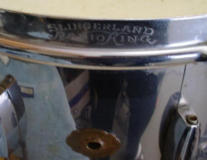
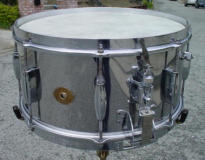
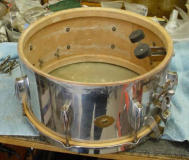
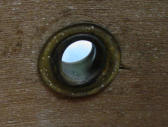
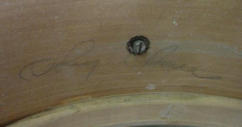

There is a lot going on with this snare drum so here we go. Let's start with the shell. This looks like a mid-1920s 6.5x15
two-piece heavy brass shell but this shell has the 1935- L&L white enamel badge that is in the same area (one panel over from
the strainer and above the bead) where the airhole would be on a mid-1920s 8 lug heavy brass shell. The badge and grommet
look to be intact with no sign of any alteration. An interesting observation is the fact that there is no "Ludwig Trade Mark" stamp
in the same panel as the strainer as you would see on a 1920s heavy brass shell. There is a standard (1932-) tone control,
normal butt plate and this shell was drilled for a P338 strainer. There are no extra holes near the strainer or anywhere else on
the shell. Now the fun begins. There are 8 Anniversary (no inserts) Imperial lugs that are machined for the hex bead of the
Anniversary-era shells but this shell has a rounded bead ala the 1920s shells. The Imperial lugs fit nicely and do not compromise
the round bead in any way. I took all the lugs off and noticed that the 2" lug hole patterns on the shell have not been altered
which is moot since the L&L tube lug and the L&L Imperial lug both have 2" center to center hole spacing. Here's the cool part;
as I've mentioned and as you can see by the photos, this is a 6.5x15 shell so the normal lugs for this shell would have been the
longer 3.5"-spaced tube lugs! So what we have here are traces of a 1920s shell along with traces of a 1935-36 Anniversary-era
shell. The top and bottom rims are the double flanged rims with 8 "ears" that you would see on the Standard Models of the
Anniversary-era and for years to come. Was there a 6.5x15 8 lug heavy brass two-piece shell just lying around at the L&L
(C. G. Conn) factory for 10+ years during the 10 tube lug-era? Ok, then how do you explain the absence of the "Ludwig Trade
Mark" stamp on the shell? The 6.5x14 and 5x14 Anniversary snare drums (hex bead) both used the same size Imperial lugs so
is this a left over shell from an earlier era? Was a shell specially made for a customer? Splain that to me Lucy...
John Aldridge thinks this drum was a special order. Drum companies of that era were very accommodating so the "special order
concept" does make sense. What do you think?
1935-36 Ludwig & Ludwig 6.5x15 8 lug nob Anniversary Standard Model
...with some leftover mid-1920s-ness
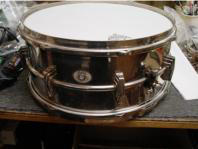
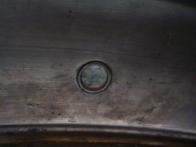
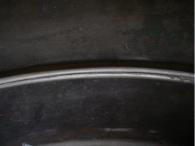
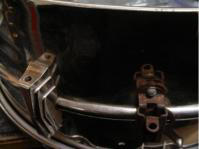
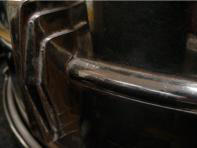
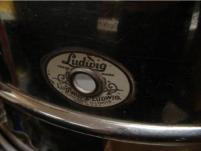

I got this drum about 5-6 Chicago Shows ago, thank you Steve Maxwell. So is this a "post-law suit" DuAll? It has to be as the
"pulley" mechanism on this drum is somewhat flimsy as compared to the "pre-law suit" DuAlls that we all know and love. There
is a lot going on with this drum so I'll try to explain it as logically as I can...as always I welcome any further information and
comments that any of you may have.
Shell: The shell/finish is solid birds eye maple. Rob Cook's book: Drum Colors 1925-1995 lists that a Slingerland maple finish
was offered from 1976 to 1986. We all know that many 1920s-40s Slingerland shells were birds eye maple with a lacquer or
pearl covering. So is this birds eye maple finish original or has this drum been stripped and re-finished? An argument for original
is that the cloud badge on this drum is tight and looks and feels intact to me (see photo) and also that maple as a finish has been
around way before the 1920s...or is this wishful thinking on my part? But, alas, a more realistic look at the shell leads me to
believe that this drum was originally finished in white lacquer. The interior had alot of white paint drippings and as much as I
would hope that Slingerland would have had a better quality control, the proof is the proof, not to mention the fact that 1920s-30s
birds eye maple was considered to be a flawed wood and therefore used for lacquer finishes. All the DuAlls that I have seen have
the Tone Flange (hubcap); this drum does not have a Tone Flange nor did it ever have one as the shell has a bearing edge and is
a full 6.5" deep. Although rare, this is not really earth shaking as page 5 of the 1934 Slingerland catalog clearly states that the
Tone Flange was an option with the other option being the earlier pre-Radio King internal tone control.
DuAll mechanism: The exterior of the DuAll mechanism on this drum looks like and functions exactly like all the other DuAll
mechanisms on drums that I own or have seen except for a 1" (+/-) slot in the lower linkage on both the lever side (right through
the "PAT. APPLIED FOR" stamp) and butt side. These slots connect to a protruding pin that connects to the internal mechanism
allowing it to move the parallel wires up or down via the extension lever. The interior DuAll mechanism on this drum is what sets
this drum apart from all the other DuAlls that I know of with the exception of another "pulley" DuAll model that my good friend Bill
Wanser had seen many years ago. There is no parallel center rod but instead there is a "pulley" type set up that moves the
parallel wires up or down as previously mentioned. The wire pulley mechanism looks like a professional/factory installation
especially at the 4 ends where the pulley wires are tied off.
Hardware: The nickel plating had the normal dirt, grime and schmutz of a 75 yr. old drum but everything cleaned and polished up
nicely. The tension rods are the normal of-the-era Slingerland stubby square versions with the smaller washers. The rims are the
normal heavy brass double flanged rims with the DuAll stamp on the top rim. The extension lever is the longer version that I have
seen on 6.5x14 Slingerland Artist Model/Fancher Tone Flange and 6.5x14 Black Beauty models. One last interesting (with a hint
of geekiness) discovery: the bottom rim on this DuAll has the early snare gates/guards that are attached on both sides via 4 flat
head screws. I took the guards off to clean/polish them and discovered that an "M" was stamped in the area just under where
the guard is attached and that same "M" was also stamped on the guard. I have since found out (thank you Dr. Carl Wenk) that
this may be what is called an "inspector's cartouche".
I decided to put a clear head on the bottom as this DuAll internal mechanism is somewhat historical and in my opinion worth
seeing.
1930s Slingerland 6.5x14 solid birds eye maple DuAll Model
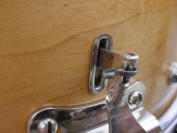
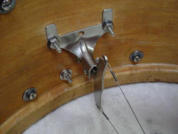
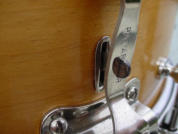
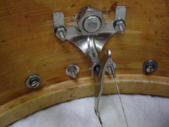



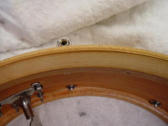
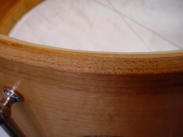
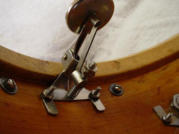
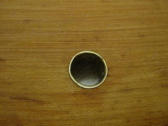


The best way to communicate with Jim is via E-mail to: savoldi1@aol.com

Curotto Collection
